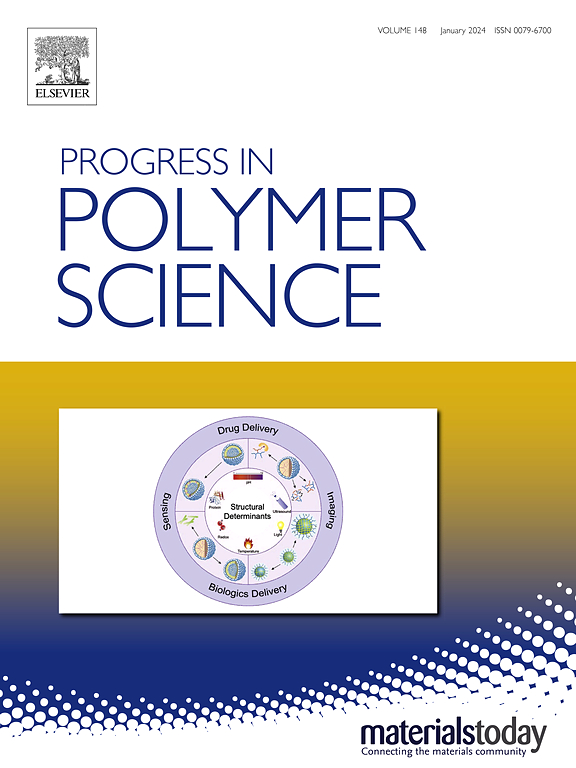Baroplastics – The future of low temperature plastic processing
IF 26.1
1区 化学
Q1 POLYMER SCIENCE
引用次数: 0
Abstract
While global annual plastic production has surpassed 400 million tons, the rate of plastic recycling remains below 10 %. Recycling rates for conventional thermoplastics remain low, largely due to the harsh conditions required for high-temperature melt-molding. These conditions promote thermo-oxidative reactions and chain scission, causing significant deterioration of polymer chains and reducing the recyclability of these materials. Additionally, the sustainability of this process is compromised by its high energy demands and harmful environmental impacts. Baroplastics provide an alternative recycling pathway that involves the use of low-temperature processing under pressure; a novel class of sustainable polymers that leverages their unique pressure-responsive properties to enable recycling at markedly reduced energy consumption and CO2 emissions. Baroplastics rely on order-to-disorder transitions (ODTs), typically of block copolymers (BCPs), that allow for a rheological transition from an ordered solid to a disordered liquid-like state that can flow and be molded. Once pressure is removed, the liquid-like state returns to its original solid form with no observed degradation of the polymeric chains. In this review, we introduce the concept of baroplastics and explore the mechanisms that underpin their distinctive ability to flow under pressure for sustainable recycling. We discuss the technological and environmental advantages of baromechanical recycling, the potential for future implementation within industry, and the use of baroplastics in nanocomposites and biological systems. Moreover, we have thoroughly reviewed the scope, modelling, and synthesis of baroplastic materials to produce a guide to this growing field.


气压塑料-低温塑料加工的未来
虽然全球塑料年产量已超过4亿吨,但塑料回收率仍低于10%。传统热塑性塑料的回收率仍然很低,主要是由于高温熔融成型所需的苛刻条件。这些条件促进了热氧化反应和链断裂,导致聚合物链的严重恶化,降低了这些材料的可回收性。此外,这一过程的可持续性受到其高能耗和有害环境影响的影响。正压塑料提供了另一种回收途径,包括在压力下使用低温处理;这是一种新型的可持续聚合物,利用其独特的压力响应特性,可以在显著降低能耗和二氧化碳排放的情况下实现回收。正压塑料依赖于有序到无序的转变(odt),通常是嵌段共聚物(bcp),它允许从有序固体到无序液态的流变转变,可以流动和模塑。一旦去除压力,类液体状态恢复到原来的固体形式,聚合物链没有观察到降解。在这篇综述中,我们介绍了气压塑性的概念,并探讨了支撑它们在压力下流动以实现可持续回收的独特能力的机制。我们讨论了气压机械回收的技术和环境优势,未来在工业中实施的潜力,以及气压塑料在纳米复合材料和生物系统中的应用。此外,我们已经彻底审查的范围,建模和合成的压力塑性材料,以产生一个指南,这一日益增长的领域。
本文章由计算机程序翻译,如有差异,请以英文原文为准。
求助全文
约1分钟内获得全文
求助全文
来源期刊

Progress in Polymer Science
化学-高分子科学
CiteScore
48.70
自引率
1.10%
发文量
54
审稿时长
38 days
期刊介绍:
Progress in Polymer Science is a journal that publishes state-of-the-art overview articles in the field of polymer science and engineering. These articles are written by internationally recognized authorities in the discipline, making it a valuable resource for staying up-to-date with the latest developments in this rapidly growing field.
The journal serves as a link between original articles, innovations published in patents, and the most current knowledge of technology. It covers a wide range of topics within the traditional fields of polymer science, including chemistry, physics, and engineering involving polymers. Additionally, it explores interdisciplinary developing fields such as functional and specialty polymers, biomaterials, polymers in drug delivery, polymers in electronic applications, composites, conducting polymers, liquid crystalline materials, and the interphases between polymers and ceramics. The journal also highlights new fabrication techniques that are making significant contributions to the field.
The subject areas covered by Progress in Polymer Science include biomaterials, materials chemistry, organic chemistry, polymers and plastics, surfaces, coatings and films, and nanotechnology. The journal is indexed and abstracted in various databases, including Materials Science Citation Index, Chemical Abstracts, Engineering Index, Current Contents, FIZ Karlsruhe, Scopus, and INSPEC.
 求助内容:
求助内容: 应助结果提醒方式:
应助结果提醒方式:


